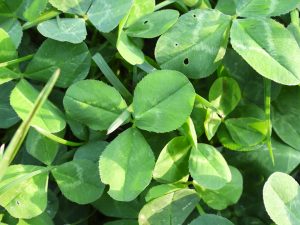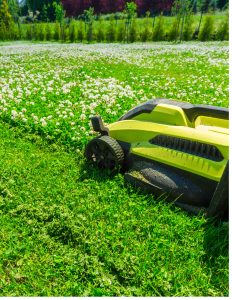Question: I am interested in alternatives to a traditional grass lawn. Is overseeding with Dutch white clover a good option?
by Melissa Otoya, Piedmont Master Gardener Intern
Since the mid-nineteenth century, Americans have prized highly manicured, weed-free grass lawns as aesthetically pleasing landscape and recreational spaces. Best management practices also demonstrate that turfgrass can benefit the environment by sequestering carbon, reducing temperature in urban heat islands and enhancing water infiltration and erosion control. However, the popularity of other alternatives to grass is growing despite societal norms and HOA requirements that often limit those options.
Why Choose an Alternative?
Nitrogen, a component of fertilizer, is an essential nutrient for healthy lawns. A steady supply of nitrogen is necessary to establish and maintain the green color, vigor and seasonal shoot density of grass lawns. However, using too much nitrogen can lead to contamination of local waterways and the Chesapeake Bay watershed. As a result, many homeowners are exploring other ways to reduce reliance on nitrogen and to minimize any negative environmental impacts of excessive or poorly-timed fertilizer application.

White Clover as a Component of Grass Lawns
Tall fescue, a cool season grass, is the predominant grass found in Central Virginia, often mixed with Kentucky bluegrass. One approach to a more sustainable lawn is to incorporate white clover into tall fescue and other cool season grass lawns. Until the common use of broadleaf herbicides in the 1950s, white clover was a standard ingredient in grass seed mixtures. This was because clovers, a member of the legume or pea family, are nitrogen-fixers, which take nitrogen from the air and fix it in the soil in a form readily available to enhance plant growth. However, since the 1950s, homeowners and the landscape industry have shifted away from this practice because the weed-killing herbicides also killed the clover.
Dutch White Clover
Dutch white clover (Trifolium repens), commonly called white clover, typically grows four inches tall with the familiar shamrock-shaped leaf and white flowers that bloom in late spring. Along with susceptibility to herbicides, other characteristics of white clover make it a controversial choice for grass seed mixtures. Like other white clover varieties, Dutch white clover sends out horizontal stems (stolons) that produce new roots and shoots at nodes along the stems. It spreads aggressively and can produce large clumps of clover that compete with the turfgrass, causing a blotchy appearance. In addition, the intense summer weed pressure of the Mid-Atlantic transition zone can overwhelm large stands of clover resulting in bare spots. Even monocultures of white clover are not recommended for lawns because of its intolerance to heavy foot traffic, shade, high heat, drought, and winter cold. These intolerances can cause the clover to die-back and increase runoff and erosion.
Microclovers
Microclovers (Trifolium repens, var. ‘Pirouette’ and ‘Pipolina’) are dwarf varieties of standard Dutch white clover with tiny leaves, a less aggressive, lower growth habit and fewer flowers. Preliminary research indicates that a turfgrass and microclover seed mix can produce a more attractive, lush, uniform lawn than Dutch white clover when seeded at recommended rates. Like Dutch white clover, microclover provides fertilizer for the turfgrass, crowds out weeds, and resists disease and insect pests, making the lawn easier to maintain and reducing the need for fertilizer and herbicides. It also provides other eco-friendly benefits as a food source for bees and its deep roots prevent soil compaction, reducing stormwater runoff and erosion.
There are some challenges to planting microclover in the lawn. The seeds are expensive and may not be available in local stores. Microclover may require periodic reseeding because it is not heat- or shade-resistant or because its top growth dies back in the winter. Although weed control is not typically a problem, most broadleaf herbicides labeled for lawn use cannot be applied because they will damage or kill microclover. In addition, while microclover resists most diseases, southern blight disease can occur in prolonged periods of high humidity and high nighttime temperatures.
Soil preparation
While seeding of a fescue-microclover lawn can be done in spring or late fall, the best time to seed is late summer or early fall to reduce the risks of competition with weeds or weather-related problems, such as heat and drought.
Microclover needs at least four hours of sun per day; if the lawn area does not get sufficient sun, look at other lawn alternatives.
Whether starting a new lawn or renovating an existing lawn, proper preparation is the key to success.
- Conduct a soil test, if one has not been done in the last two to four years. Amend the soil, as recommended.
- Prepare the soil to a depth of four to six inches for a new lawn. For an established lawn, mow, remove weeds, and do core aeration.
- Incorporate organic matter, such as compost.
- For a new lawn, spread about two inches of organic matter over and till it into the soil and grade the soil before seeding.
- For an established lawn, apply a ¼ to ½ inch organic layer over the lawn and rake it.
- Sow the seed at the recommended rates for overseeding (six – eight pounds per 1,000 square feet for tall fescue) and microclover (three to five percent by weight). Higher rates of microclover are not recommended and above ten percent may result in a lawn that is mainly microclover.
- Mulch with high quality straw mulch (about two to three bales per 1000 square feet) for a new lawn to retain soil moisture and reduce erosion potential.
- Keep the soil moist but not saturated until the fescue and microclover groundcover is well established.

Maintenance
Long term health of the lawn depends on proper mowing, fertilization, and hydration.
- Mow to a height of three to four inches and do not remove more than one third of the grass growth at one time. Keep mower blades sharp. Flowers can easily be removed by mowing, if desired.
- Leave grass clippings on the lawn to recycle nitrogen back into the lawn. Studies have demonstratedthat nitrogen fertilizer applications can be reduced when mowing clippings are left on the lawn.
- Retest the soil periodically. Maintain a 6.0 – 7.0 soil pH for a healthy grass and microclover lawn.
- Monitor moisture and water, as needed, to ensure that the lawn receives one to one and a half inches of water per week. Because microclover is more drought tolerant than fescue, the lawn may need less supplemental watering than a traditional turfgrass lawn. Water when soil feels dry to touch or signs of moisture stress are evident. Water in the morning hours, deeply, and infrequently to encourage deeper root growth.
Weed Control
To help control weeds, be sure to sow seed at the recommended time and rate and maintain the recommended soil pH. Consistent watering practices are also important. However, broadleaf, and annual grass weed pressure may require occasional herbicide application. Be sure to read the label and only use herbicides that target specific weed types, not clover.
Choosing Microclover
Incorporating microclover into your lawn can be a good, eco-friendly alternative to the “weed and feed” paradigm of the past.
If you choose to establish a turfgrass and microclover lawn, start with a grass seed mixture containing a turfgrass variety recommended for the Mid-Atlantic region by the Virginia Cooperative Extension. In addition, consider buying a seed mixture with microclover seed coated with a Rhizobium bacterium, which helps promote healthy microclover growth. A word of caution: don’t plant a monoculture of microclover. There is no research to support successful use of 100 percent microclover groundcover.
References
“A mixture of grass and clover combines the positive effects of both plant species on selected soil biota,” van Eekern, Nick, et.al, ScienceDirect, Volume 42, Issue 3, 2009.
“Cool‐season Lawn Performance as Influenced by ‘Microclover’ Inclusion and Supplemental Nitrogen“, Bigelow, Cale A., et al., International Turfgrass Society Research Journal, Volume 14, Issue 1, 2022.
“Dwarf White Clover Supports Pollinators, Augments Nitrogen in Clover–Turfgrass Lawns, and Suppresses Root-Feeding Grubs in Monoculture but Not in Mixed Swards,” Potter, Daniel A., et al., MDPI, Sustainability, Volume 13, Issue 2, 2021.
“Microclover – Tall Fescue Lawns in the Mid-Atlantic Region”, Turner, Dr. Thomas and Carrol, Dr Mark, Department of Plant Science & Landscape Architecture, University of Maryland, 2015.
“Microclovers Making a Comeback as Lawns Become More Diverse”, Flowers-Kimmerle, Nicole, College of Agriculture, Consumer, & Environmental Sciences, 15 May 2022.
“Preplant Cultivation Techniques and Planting Date Effects on White Clover Establishment into an Existing Cool-season Turfgrass Sward,” Sparks, Bret, et al., American Society for Horticultural Science, HortScience, Volume 50, Issue 4, 2015.
“Taking a Stand on Clover,” Toher, Drew, Pesticides and You, Volume 36, No. 1, Spring 2016.
“The Promise of a Low-Input Tall Fescue/Microclover Lawn”, Lathrop, Brian, Fairfax Gardening, Fairfax County Master Gardeners, 7 Apr 2023.
“Turf-type Tall Fescue and Microclover Mixture”, Carignan, C., University of Maryland, University of Maryland Extension, UMD Turfgrass Technical Update, 11 May 11 2023.
“2025-26 Virginia Turfgrass Variety Recommendations”, Goatley, Jr., Michael et. al. Virginia Tech, Virginia Cooperative Extension, Publication SPES-727NP, 29 Aug 2025.